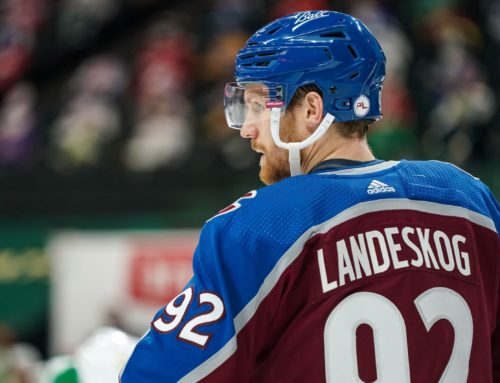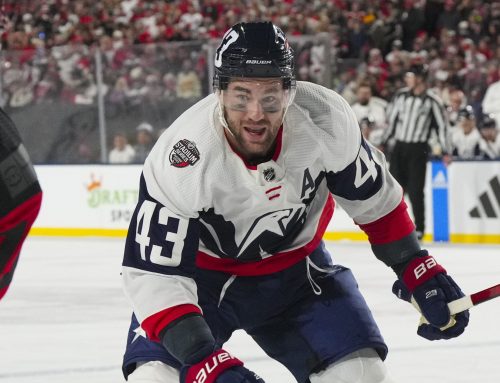Capped: Maintaining Competitiveness in Dynasty Leagues and Contracts for Kucherov, Point, and Others
Andrew Santillo
2023-12-14
Hey-o to all my cap-friendlies out there and welcome back! Last week I caught myself watching the Washington Capitals, not because of fantasy but more rather I stacked against this club in DFS that night. Had plenty of good reason to do so, this Caps club is a shell of what it used to look like and might, if all things come together, finish at or around the .500 mark. That got me thinking, just how do dynasty's end? Or maybe not dynasties, let's just call it how do windows in the NHL and just how do they close shut?
I saw this firsthand with the Blackhawks during their run in the 2010's. I went to the parade in '13. Went again in '15. I thought like so many other fanbases out there that have had similar accomplishments that this team, this city, and all the fans would have this sustained success forever up until numbers are raised into rafters. That all came to a screeching halt in 2017 in a series against Nashville where if you go back and watch I think the Hawks never once had an offensive possession, or so it felt. Just like that, it was over. All the memories of Cup games, OT's and games against Vancouver that would reach 2 am Central time didn't much matter anymore as one question loomed over it all – How did this all come to an end? That same Capitals club I watched last week is a perfect example of what I'm talking about, and I think it all comes back to the salary cap (mostly…), so how can we potentially keep championship windows open?
First off, I think we can all agree on two things: you need good players, and you need a good coach. We're all in agreement there, right? Perfect let's move on to the types of salaries star players optimally would be making against the cap. I like to think that in a championship window you can't cheap out, and that's true. Now that doesn't mean go hog wild in spending if you so happen to win a Cup, but I think this pertains more to those clubs that are right on the cusp, smart spending in that scenario is what you need to make happen so that the contracts for your important players do not inflate your cap to prohibit spending elsewhere. I also like to think that the "model" franchise in the NHL is the one that won the Stanley Cup last but for this example here I want to look at Tampa Bay, who leads the NHL in smart spending…if they were to track such a thing. Here's an example of some of their most important contracts (from CapFriendly):
Brayden Point – 8 years x $9.5M – 27 years old
Anthony Cirelli – 8 years x $6.25 – 26 years old
Nikita Kucherov – 8 years x $9.5M – 30 years old
Steven Stamkos – 8 years x $8.5M – 33 years old
Now, these are the contracts length and amount when each of these players were signed, with their current age right now. I tell you that to tell you this, and I think it's maybe one of the better metrics to use when signing a player. I can't take full credit for this, as it was told to me by someone I know whom briefly worked as a special assistant to the Detroit Tigers, but I have tweaked it slightly for hockey. They said that they would use this equation when signing a player to an extension – You take the players age, divide it by two, then add the contract. If the number you come up with is at or below 22, good contract. Anywhere above, the contract will not age well on your books. The other part of this metric is that club option years do not count against you, but player options do, so if your number is 23 but the last year is a club option, you are back down at 22. Now keep in mind this was used for baseball where they don't have a hard cap system like we do in the NHL to where you can go sign say, oh I don't know, a once in a generation superstar to $700M but only pay him $20 of that…or like in the NFL where you can't convince me the salary cap is actually real, I don't believe you. Back here on planet Earth with the NHL we do have to abide by the number given and if we go ahead and use that metric we see the names of those Tampa players above land at each number:
Brayden Point – 20
Anthony Cirelli – 20.5
Nikita Kucherov – 21
Steven Stamkos – 21
Not too bad, huh? Plus, we can look at the Steven Stamkos contract as a perfect example here as he is on the last year of this current contract. Would any club want to take that original term and AAV for Stamkos? Yes, 100 times out of 100. This is what helps to keep windows open, money that isn't being spent on aging players that aren't in a position to help your club win right now. This metric above is not an end all be all by any stretch, but I like to use it for contracts that are signed across the league. I have run into two issues with it, one being NHL players coming into the NHL at an earlier age, and the second being is how to weigh it on defensemen and goaltending. Believe me, an older defenseman that can no longer produce is much easier to pick out than a forward and goaltenders are well, goaltenders. I stood by for years that only goalies named Carey Price should get a large contract.
The next entity that keeps windows open is the draft. Yes, yes, I know obvious right but think about it for a second with me here. I would argue that the draft picks that have the highest percentage of "hits" that can impact your club in a positive way are honestly picks #1 and #2 on most years, it's just how it is with the talent separation in most cases. If you're continuously a competitive club, you're nowhere close to picking that high in the draft, never sniff the lottery, and odds are you're somewhere in the late 20's. The difference between a player in that range of a late first rounder compared to a middle second round pick may be marginal, but my thought here is that of course it helps to hit on a player in the top two rounds, but it's those clubs that can find a player in rounds three or four that can benefit cap wise. Just think about it this way: what's more expensive, drafting a player in the third round that helps your club down the road or signing a player with a free agency sticker tax to help fill a depth role? All of a sudden that player you forgot your club even picked up on the second day of the draft can help you afford a top six forward or top four defenseman.
Last to touch on for maintaining long-term success, without question: the front office. The most important thing here, especially in the NHL, is you can't bet against yourself. Time and time again I see players being signed that I can't figure out who the other clubs out there would be that would sign a player to a higher contract? I nicknamed this "Seabrooking"…for reasons I'm sure you can understand. Look, these things may be no brainers on the surface, but if that's the case how come so many clubs seemingly can't get out of their own way and get this right? I don't want to add luck to this but that has to go into the mix as well…everything has to be in the right place at the right time, but the right decisions have to be made to go along with it all.
*For continued fantasy news and notes, follow me on Twitter @ndySanz.





 COL
COL WPG
WPG NSH
NSH VAN
VAN WSH
WSH NYR
NYR L.A
L.A EDM
EDM TOR
TOR CAR
CAR FLA
FLA DAL
DAL VGK
VGK T.B
T.B PIT
PIT SEA
SEA
